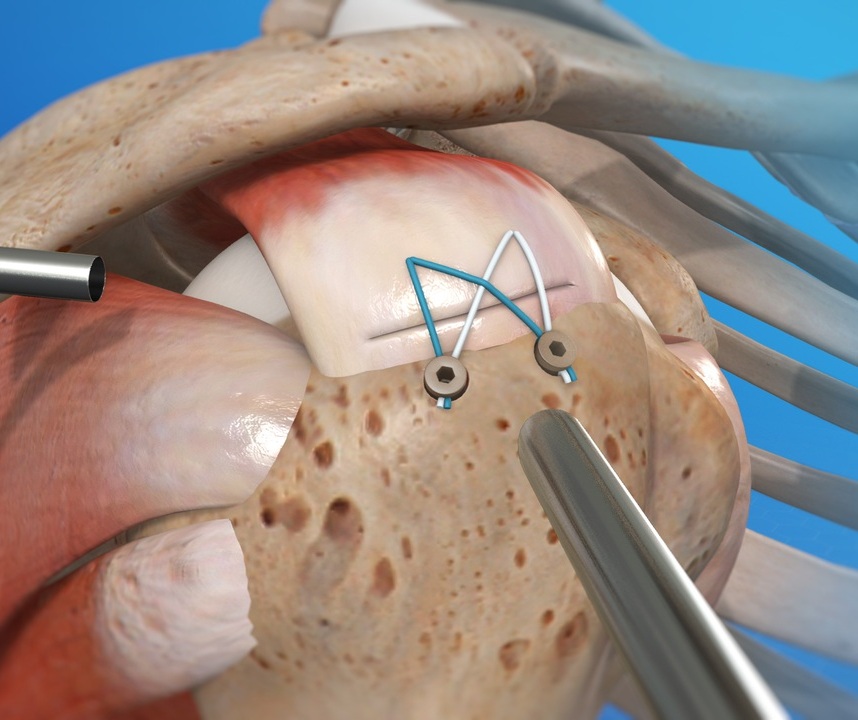Rotator Cuff Repair
Repair torn tendons, muscles, and ligaments in the shoulder

Learn more what we do on this Treament
The rotator cuff is made up of 4 main muscles which work together to move and rotate our arms. However, if a tear happens in any of these muscles, a rotator cuff tear occurs. A rotator cuff tear can occur partially (where part of the rotator cuff is still attached to the arm bone) or completely (where the whole rotator cuff is completely detached from the arm bone).
Depending on the severity of your rotator cuff tear, there are 3 types of surgeries available for a rotator cuff repair. These are:
- Collagen scaffold augmentation
- Superior capsule reconstruction
- Lower trapezius transfer

Rotator cuff comprises 4 main muscles.
Rotator cuff repair is a type of surgery to repair torn tendons, muscles, and ligaments in the shoulder. A surgeon can perform the procedure through traditional open repair (large open incisions), mini-open repair (smaller incisions), or arthroscopic repair (small incisions using an arthroscope). Arthroscopy is becoming increasingly common for rotator cuff repair injuries as it is less invasive with much smaller incisions.
Rotator cuff repair is normally advised when shoulder pain gets worse or does not improve, even during rest and after several weeks of physiotherapy. It is also recommended for those with shoulder weakness, a traumatic injury, or rotator cuff tendonitis.
Rotator cuff injuries can happen due to wear and tear of the tendons in the shoulder over time. Repetitive activities that involve using the shoulder excessively such as heavy lifting can also lead to damaged tendons and ligaments. Rotator cuff injury can also happen during falls or accidents.
As rotator cuff injuries happen due to tears of the tendons, ligaments, or muscles, surgery involves re-attaching them back to the bone.
When done through arthroscopy, the surgeon inserts a device called an arthroscope through small incisions in the shoulder. An arthroscope allows the surgeon to see inside the shoulder and make the necessary repairs, as it is connected to a video monitor. Suture anchors may be used to fix the damaged tendons and ligaments. They do not need to be removed from the body and some types may dissolve over time.
Rotator cuff repair procedures are normally conducted under general anesthesia so the patient will not be awake during the surgery. After the procedure, the surgeon and his team will close and dress the incision site. The results will be discussed with you later, where you may be allowed to view photos or videos of the procedure with your doctor.
Depending on the severity of the rotator cuff injury, you may need to return to the doctor for follow-up treatments or physiotherapy.
- Minimally invasive when done through arthroscopy
- Resolves shoulder pain
- Strengthens the muscles, tendons, and ligaments in the shoulder
- Improves quality of life
A rotator cuff repair can treat the following conditions:
- Rotator cuff tendonitis
- Rotator cuff tears
- Damaged tendons and ligaments
After the procedure, your hand, arm, and shoulder will be swollen. It will start to get better in a few days, however, it will take approximately 4 to 6 months before you can use your shoulder fully. Physiotherapy and/or rehabilitation exercises will aid in building your strength and regaining the motion of the joint.
The exact results depend on your age and severity of the rotator cuff repair. However, most patients see great improvement in their rotator cuff and shoulder after surgery. In time, your shoulder should get stronger, more flexible, and less painful.
Work closely with your orthopaedist and follow their recommendations for exercises and activities for the best results. Your orthopaedist can give you a better idea of what to expect based on your individual needs and circumstances.
